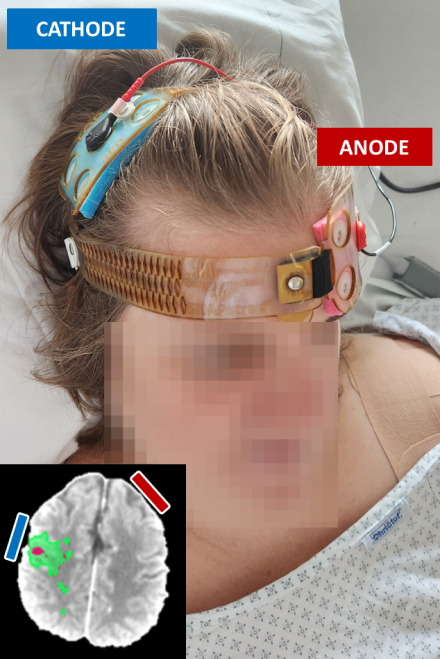Final ID: WP2
Transcranial Direct Current Stimulation Is Safe and Feasible in Hyperacute Ischemic Stroke
Abstract Body: Introduction: Cathodal transcranial direct current stimulation (C-tDCS) is a potential neuroprotective method in the hyperacute phase of ischemic stroke. In rodent models, C-tDCS reduced final infarct volume and improved functional outcome. Our aim was to assess safety, tolerability, feasibility, and potential efficacy of C-tDCS in stroke patients with salvageable penumbra.
Methods: Our study was a single-center, double-blind, randomized, sham-controlled (3 active: 1 sham), 3+3 dose-escalation trial. Inclusion criteria were stroke due to occlusion of the internal carotid or middle cerebral artery, last well-known time within 24 h, evidence of substantial penumbra on baseline CT perfusion, and ineligibility for mechanical thrombectomy. We applied C-tDCS at six dose tiers over the affected primary motor cortex (1 or 2 mA for 20 min in 1 to 3 cycles with 20 min breaks). The primary safety outcome was the symptomatic intracranial hemorrhage (SICH) rate at 24 h post-stimulation. The secondary safety outcomes were the rates of asymptomatic intracranial hemorrhage (AICH), early neurologic deterioration, serious adverse events, and mortality within 90-day follow-up. Tolerability was assessed by the rate of patients completing the entire stimulation period and by structured questionnaires. The success threshold for feasibility was median randomization-to-C-tDCS start time within 10 min in the last ten patients. Exploratory efficacy outcomes included infarct growth at 24 h, and National Institute of Health Stroke Scale (NIHSS) and modified Rankin Scale at day 90.
Results: A total of 25 patients were enrolled (19 active, 6 sham), mean age (SD) 81 (12) years, 9 males, median NIHSS (Q1–Q3) 8 (6–16) points. Ten active and 4 sham patients were treated with thrombolysis. No SICH and 3 AICH (2 after thrombolysis) occurred in the active arm. We observed no significant difference in serious adverse events. The mortality rate was also comparable (4 active vs 2 sham patients). C-tDCS was well tolerated, all patients completed the stimulation period. Side effects were only mild and transient. C-tDCS was feasible, median randomization-to-C-tDCS start time was 8 (7–9) min. No significant differences in other outcome measures were observed.
Conclusions: The application of C-tDCS in hyperacute ischemic stroke was safe, well tolerated, and feasible. Our results support the use of C-tDCS in larger efficacy trials.
Methods: Our study was a single-center, double-blind, randomized, sham-controlled (3 active: 1 sham), 3+3 dose-escalation trial. Inclusion criteria were stroke due to occlusion of the internal carotid or middle cerebral artery, last well-known time within 24 h, evidence of substantial penumbra on baseline CT perfusion, and ineligibility for mechanical thrombectomy. We applied C-tDCS at six dose tiers over the affected primary motor cortex (1 or 2 mA for 20 min in 1 to 3 cycles with 20 min breaks). The primary safety outcome was the symptomatic intracranial hemorrhage (SICH) rate at 24 h post-stimulation. The secondary safety outcomes were the rates of asymptomatic intracranial hemorrhage (AICH), early neurologic deterioration, serious adverse events, and mortality within 90-day follow-up. Tolerability was assessed by the rate of patients completing the entire stimulation period and by structured questionnaires. The success threshold for feasibility was median randomization-to-C-tDCS start time within 10 min in the last ten patients. Exploratory efficacy outcomes included infarct growth at 24 h, and National Institute of Health Stroke Scale (NIHSS) and modified Rankin Scale at day 90.
Results: A total of 25 patients were enrolled (19 active, 6 sham), mean age (SD) 81 (12) years, 9 males, median NIHSS (Q1–Q3) 8 (6–16) points. Ten active and 4 sham patients were treated with thrombolysis. No SICH and 3 AICH (2 after thrombolysis) occurred in the active arm. We observed no significant difference in serious adverse events. The mortality rate was also comparable (4 active vs 2 sham patients). C-tDCS was well tolerated, all patients completed the stimulation period. Side effects were only mild and transient. C-tDCS was feasible, median randomization-to-C-tDCS start time was 8 (7–9) min. No significant differences in other outcome measures were observed.
Conclusions: The application of C-tDCS in hyperacute ischemic stroke was safe, well tolerated, and feasible. Our results support the use of C-tDCS in larger efficacy trials.
More abstracts on this topic:
A Delayed Diagnosis of Anti-HMG-CoA Reductase Immune-Mediated Necrotizing Myopathy
Jadhav Reshma, Shekar Arush, Westenhaver Zack, Skandhan Amith
BXOS110 for Acute Ischemic Stroke Treatment (BEST): A Multicenter, Double-Blind, Randomized, Placebo-Controlled, Phase 2 TrialDing Yarong, Li Shuya, Wang Zhe, Li Zixiao, Meng Xia, Zhao Xingquan, Wang Yongjun, Li Zixiao
Readers' Comments
We encourage you to enter the discussion by posting your comments and questions below.
Presenters will be notified of your post so that they can respond as appropriate.
This discussion platform is provided to foster engagement, and simulate conversation and knowledge sharing.
You have to be authorized to post a comment. Please, Login or Signup.
Rate this abstract
(Maximum characters: 500)

